Effects of flexible prepartum supplementation strategies on cow-calf and subsequent progeny feedlot performance in a May-calving herd
IF 1.5
Q3 AGRICULTURE, DAIRY & ANIMAL SCIENCE
引用次数: 0
Abstract
Objective
The objective of this study was to evalu- ate the effects of minimal and flexible supplementation strategies on reproduction, cow BW, and subsequent calf performance in May-calving mature cows grazing upland native range.
Materials and Methods
Cows received one of 3 sup- plementation strategies: (1) 0.227 kg per day of a 30% CP distillers-based supplement (HalfSupp), (2) 0.454 kg per day of a 30% CP distillers-based supplement (Supp), or (3) brief and intermittent supplementation of Supp at 0.454 kg/cow based on periods of acute environmental stress, such as snow cover and wet winter events, which is best described as flexible supplementation (Flex). Supple- mentation was initiated in January each year and termi- nated approximately 30 d before the start of the calving season in April. After weaning, steers grazed subirrigated meadow with a dried distillers grain supplement until May. In May, all steers grazed subirrigated meadow with- out additional supplement until August/September when steers were shipped to the feedlot. Steers were placed in a GrowSafe feeding system for the rest of the finishing feeding period.
Results and Discussion
Cow BW was not different at the initiation of supplementation in January. However, cows fed HalfSupp had a lighter BW at precalving and tended to have a lighter BW at prebreeding than their counterparts. After a 45-d breeding season, pregnancy rates were not influenced by prepartum supplementation strategies. Prepartum supplementation strategies did not influence preweaning calf BW at birth, prebreeding, and weaning. In addition, steer backgrounding BW was also not influenced by their dam’s prepartum supplementation strategy. Upon entry into the feedlot, steer feedlot perfor- mance (BW, ADG, and feed efficiency) was not influenced by their dam’s prepartum supplementation strategy. After slaughter, no carcass characteristics were affected by the dam’s prepartum supplementation strategy.
Implications and Applications
Considering the cost of prepartum supplementation, feeding a protein supple- ment just during environmentally stressful periods during gestation appears to be a viable alternative to more conventional methods and reduces winter feed costs.
灵活的预备饲料补充策略对5月产犊牛群犊牛及其后代饲育性能的影响
本研究的目的是评估少量和灵活的补充策略对放牧山地5月产犊的成熟奶牛的繁殖、奶牛体重和随后的小牛生产性能的影响。材料和方法母猪接受3种补充策略中的一种:(1)每天0.227 kg的30% CP酒糟饲料(HalfSupp),(2)每天0.454 kg的30% CP酒糟饲料(Supp),或(3)根据急性环境应激时期(如积雪和潮湿的冬季事件)以0.454 kg/头的速度短暂和间歇地补充Supp,这最好被描述为灵活补充(Flex)。每年1月开始补食,在4月产犊季节开始前30天左右结束。断奶后,用干酒糟谷物补充放牧,直到5月。在5月,所有的阉牛在没有额外补充的情况下放牧,直到8月/ 9月,阉牛被运到饲养场。在肥育期的其余时间里,阉牛被放置在GrowSafe饲喂系统中。结果与讨论1月份开始添加时牛的体重无显著差异。然而,饲喂半补给量的奶牛在产犊前的体重较轻,并且在预配种时的体重往往较轻。在45 d的繁殖季节后,孕前补充策略对妊娠率没有影响。预备饲料补充策略对犊牛出生、预备育种和断奶时的体重没有影响。此外,犊牛背景体重也不受饲粮补充策略的影响。进入饲养场后,母猪的生产性能(体重、平均日增重和饲料效率)不受饲喂前补饲策略的影响。屠宰后,坝前补料策略对胴体性状无影响。考虑到预备饲料补充的成本,在妊娠期环境紧张时期饲喂蛋白质补充似乎是一种可行的替代方法,可以降低冬季饲料成本。
本文章由计算机程序翻译,如有差异,请以英文原文为准。
求助全文
约1分钟内获得全文
求助全文

 求助内容:
求助内容: 应助结果提醒方式:
应助结果提醒方式:


